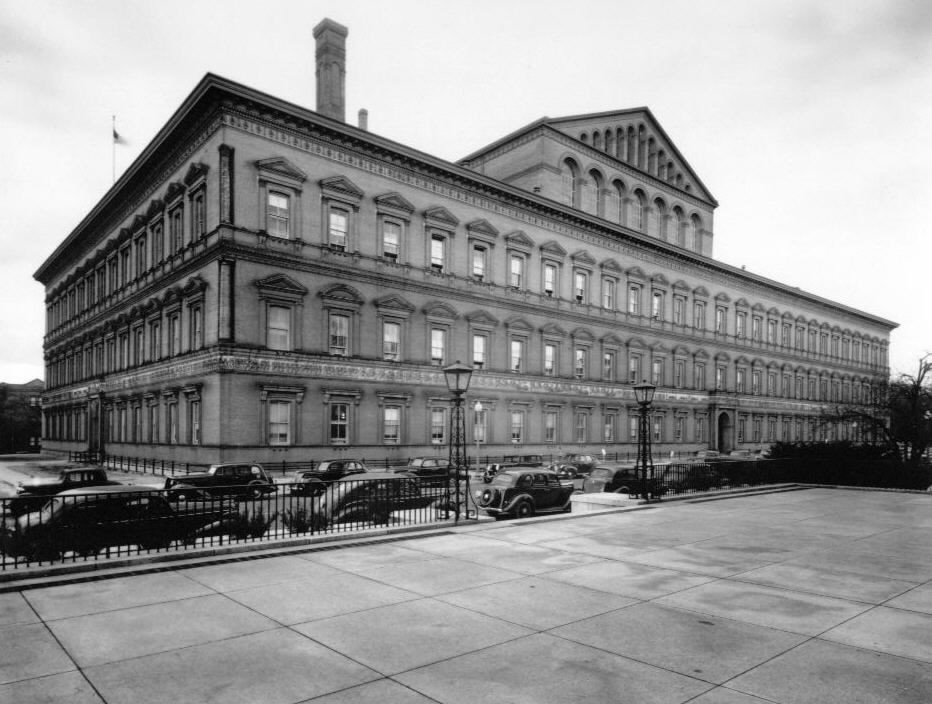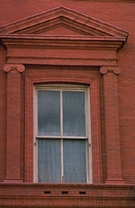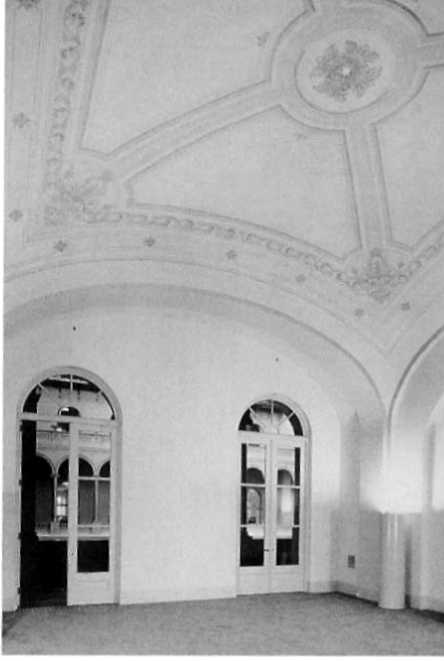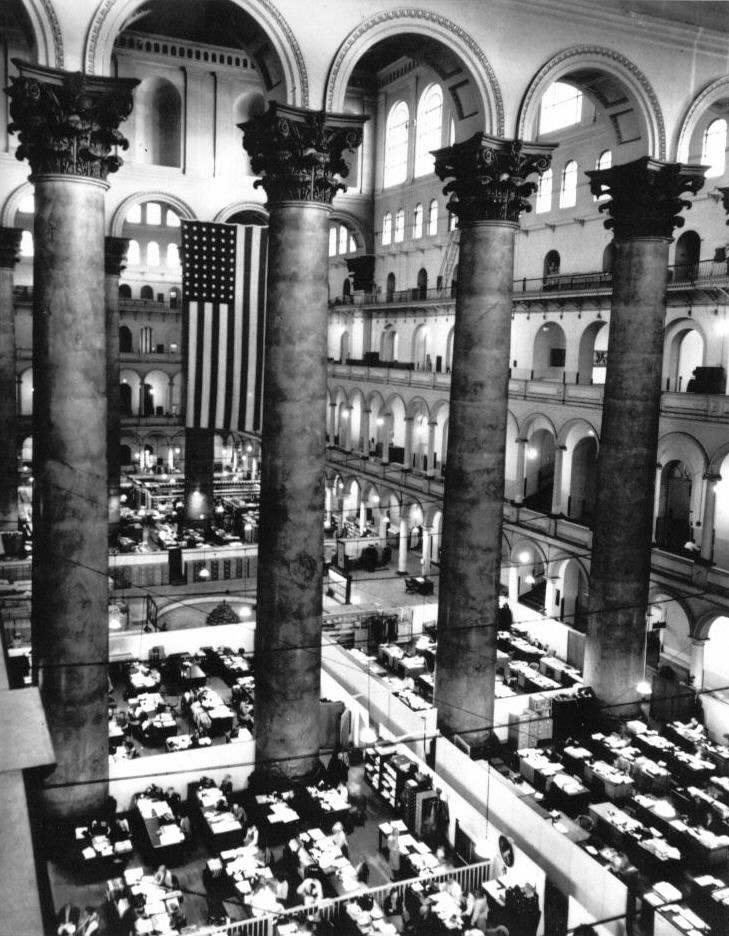How GAO Built Its Dream House
| Return to Table of Contents | < Previous Chapter | Next Chapter > |
Chapter 4, GAO Moves into "Meigs’s Old Red Barn"
 During its first 30 years
of operation, GAO housed its staff in various locations. The agency rented space for offices and records storage in several buildings in Washington and across the Potomac River in Northern
Virginia. From 1926 to 1951, GAO's top officials and many of its employees were headquartered in the Pension Building at 4th and F Streets, N.W. The Pension Building presently is home
to the National Building Museum. It is a well-known landmark in Washington, D.C. The Pension Building often is described as a memorial to Civil War veterans, since the terra cotta
frieze that surrounds the building depicts infantry, cavalry, artillery, naval, medical and quartermaster units from that conflict. However, despite popular perceptions, it never was
designated officially as a war memorial. Designed by General Montgomery C. Meigs, the building was constructed in the 1880s to house the government agency that administered military
pensions. In 1926, the Pension Bureau, which was an agency of the Department of the Interior from 1849 to 1930, moved to the department's headquarters building, vacating Meigs's structure
for GAO.
During its first 30 years
of operation, GAO housed its staff in various locations. The agency rented space for offices and records storage in several buildings in Washington and across the Potomac River in Northern
Virginia. From 1926 to 1951, GAO's top officials and many of its employees were headquartered in the Pension Building at 4th and F Streets, N.W. The Pension Building presently is home
to the National Building Museum. It is a well-known landmark in Washington, D.C. The Pension Building often is described as a memorial to Civil War veterans, since the terra cotta
frieze that surrounds the building depicts infantry, cavalry, artillery, naval, medical and quartermaster units from that conflict. However, despite popular perceptions, it never was
designated officially as a war memorial. Designed by General Montgomery C. Meigs, the building was constructed in the 1880s to house the government agency that administered military
pensions. In 1926, the Pension Bureau, which was an agency of the Department of the Interior from 1849 to 1930, moved to the department's headquarters building, vacating Meigs's structure
for GAO.
Notable inside the Pension Building is the enormous Great Hall, which served as a site for presidential inaugural balls between 1885 and 1909 and, after a break, again starting in the 1970s. The hall measures 116 by 316 feet and features three courts separated by screens of Corinthian columns. Each column is made up of 70,000 bricks, painted to look like Sienna marble, and rising 75 feet. Seeking to improve the poor ventilation that characterized most cramped nineteenth century office buildings, Meigs placed offices in three stories around the perimeter of the hall. A fourth floor held storage rooms.
 Meigs designed a unique ventilation system
for the building. His plan called for air to be drawn in from windows and, during the winter, through three openings under each window, and then to circulate into the Great Hall. (Present-day
visitors to the National Building Museum still can spot the three openings in the brickwork under the windows.) As air entered and warmed up inside the building, it was drawn up to high
clerestory windows at the top of the building, where it exited. In 1885, Meigs wrote that the volume of air in the Great Hall was replaced every two minutes.
Meigs designed a unique ventilation system
for the building. His plan called for air to be drawn in from windows and, during the winter, through three openings under each window, and then to circulate into the Great Hall. (Present-day
visitors to the National Building Museum still can spot the three openings in the brickwork under the windows.) As air entered and warmed up inside the building, it was drawn up to high
clerestory windows at the top of the building, where it exited. In 1885, Meigs wrote that the volume of air in the Great Hall was replaced every two minutes.
In 1980, Congress designated the Pension Building as the site of the National Building Museum. Although it presently celebrates achievements in building, the structure has had an equal share of critics and admirers through the decades. In 1945, Rep. Fritz G. Lanham noted of the Pension Building that "years ago, it was described by some wag as three red barns, one on top of another." Other observers called the building “Meigs’s old red barn.”
 Between June and September 1926, many of GAO's employees moved into the new headquarters building. Comptroller General John R. McCarl occupied offices on the second
floor of the Pension Building, in the southwest corner. The suite included a large open-hearth fireplace and originally served as the office of the Commissioner of Pensions. Several of the
executive offices were painted in the 1880s and 1890s with elaborate decorations, but only the commissioner's office later occupied by McCarl still retains the original ceiling decoration. It was
carefully cleaned and restored in 1984, using a painstaking process that relied on artists' erasers.
Between June and September 1926, many of GAO's employees moved into the new headquarters building. Comptroller General John R. McCarl occupied offices on the second
floor of the Pension Building, in the southwest corner. The suite included a large open-hearth fireplace and originally served as the office of the Commissioner of Pensions. Several of the
executive offices were painted in the 1880s and 1890s with elaborate decorations, but only the commissioner's office later occupied by McCarl still retains the original ceiling decoration. It was
carefully cleaned and restored in 1984, using a painstaking process that relied on artists' erasers.
 In
the Pension Building, GAO's voucher clerks spilled over from the perimeter offices, filling the Great Hall. A guidebook from the 1930s noted that to appreciate the immensity of
the Great Hall, "rising 120 feet in height and covering an approximate floor area of over 100 by 300 feet in extent, it is necessary to peer down from above upon the pigmy [sic] clerks below,
stowing away endless Government documents, like Lilliputians in a Brobdingnagian hall." Photographs taken in the 1920s show a Great Hall filled with rows of desks. By 1940, the fountain in the
middle of the Great Hall had been shut off and records stored on top of it. The fountain was restored in the 1980s, after establishment of the National Building Museum.
In
the Pension Building, GAO's voucher clerks spilled over from the perimeter offices, filling the Great Hall. A guidebook from the 1930s noted that to appreciate the immensity of
the Great Hall, "rising 120 feet in height and covering an approximate floor area of over 100 by 300 feet in extent, it is necessary to peer down from above upon the pigmy [sic] clerks below,
stowing away endless Government documents, like Lilliputians in a Brobdingnagian hall." Photographs taken in the 1920s show a Great Hall filled with rows of desks. By 1940, the fountain in the
middle of the Great Hall had been shut off and records stored on top of it. The fountain was restored in the 1980s, after establishment of the National Building Museum.
The Pension Building could not house all of GAO’s employees, many of whom worked in leased office and warehouse space in Washington and in suburban Alexandria, Virginia. In 1937, the Acting Comptroller General said that some of these buildings were "poorly heated and lighted, with little or no ventilation, necessitating the use of hand flashlights for light, and men have to work in lumber jackets, heavy shoes, and mittens in winter to keep comfortable."
During the 1930s, Congress considered a number of options to aid GAO, including expansion of the Pension Building. In 1934, the Commission of Fine Arts approved plans to expand and remodel the Pension Building, adding wings, altering the roof, and resurfacing the brick walls with stone. The chairman of the commission was no fan of Meigs's design, for he wrote that the remodeling plan provided "a satisfactory solution of the problem of transforming into a building of appropriate monumental character a building which during its entire lifetime has been ridiculed both by the public and by the architectural profession." He called the Pension Building "one of the three or four eyesores of the city." Times and tastes change, and by contrast, an article in The Washington Post in January 2001 called Meigs’s structure, "Washington’s prettiest building."
| Return to Table of Contents | < Previous Chapter | Next Chapter > |

